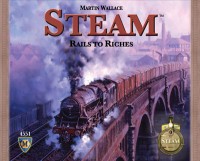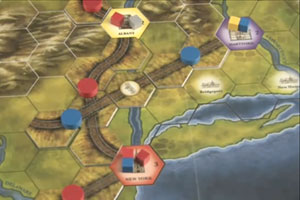
Steam

In Steam you build railroads and deliver goods along an ever changing network of tracks and stations. You build the tracks, upgrade towns, improve your train, and grab the right goods to make the longest, most profitable deliveries. Score your deliveries and add to your income or victory points, balancing your need to invest against your quest to win the game.

Steam contains a beautiful, double-sided game board. The map on each side depicts terrain, towns, and cities at the start of the railway age. The map of the northeastern USA and neighboring Canada is ideal for 3 or 4 players. Use the map of Europe's lower Rhine and Ruhr region when playing a 4 or 5 player game. You can play Steam on any number of current and future variant and expansion maps, so we include pieces for 6 players.
Steam is the culmination of Martin Wallace's classic railroad game series. It contains a brilliantly balanced standard game, and a very rich, elegant basic game. Both offer you unparalleled flavor and fun.
User Reviews (2)
Add a Review for "Steam"
You must be logged in to add a review.


Background
There are a lot of train games out there. There is Ticket to Ride, 1830, Chicago Express, Union Pacific, 1856, Steel Driver, Last Train to Wensleydale, On the Underground, Stephensons Rocket, Empire Builder, Silverton, Days of Steam, and at least 600 other train games. But Steam is, in my opinion, the best. Steam was developed over several years by Martin Wallace. Wallace had many incarnations of the game that were published along the way: Age of Steam, Railroad Tycoon and Railways of the World. Steam is most likely the final version of this game that will be published. It rides perfectly between the simplicity of Ticket to Ride and complexity and dryness of the 18xx series (any train game that begins with 18 and refers to year of the 19th century such as 1830 or 1870). Let’s take a look at what makes it great.
Gameplay
Steam is all about the law of supply and demand. All of the players share in one main game board that is a map of the Eastern United States. The map contains major cities which contain goods that players will compete to deliver to other cities with a demand for that type of good. Your goal in the game is to score victory points by transporting goods over routes that you build to cities that are in demand of those goods. The more circuitous the route the higher the score.
Steam takes place over 7 to 10 turns (determined by number of players) with six phases each turn. Let’s look at the flow of Steam’s gameplay for a turn over these six phases:
Phase One – Action tile selection
Players will choose from various action tiles (very similar to role selection in other games) which will determine player order and any special abilities. These special abilities include building extra track, building first track, upgrading locomotives, restocking city goods and upgrading towns into cities (to hold more goods).
Phase Two – Build Track
Unless a player choses the Engineering action tile, which allows them to build four, players will be limited to building three pieces of track on their turn. The goal is to create routes to deliver goods from one city to another but track costs money and there are limitations to where you can build. These limitations will present the steepest learning curve of the game. One limitation is that a player cannot build where someone else has. This is where people can be “mean” and cut one another off.
Phase Three – Move Goods or Improve Locomotives
Moving goods is how a player wins the game. When a player moves goods they have the choice of scoring victory points or earning income. Another option during this phase is to improve their locomotives. There is no point in having a nice long route if a players train is not powerful enough to cross it.
Phase Four – Collect Income and Pay Expenses
Money is tight in Steam. Based on goods delivery and the debt a player is carrying, they could either be collecting money or paying it during this phase.
Phase Five – Determine Turn Order for Next Turn
Based on the action tiles selected, the player order for the next turn is determined.
Phase Six – Set Up New Turn
All action tiles are returned and the turn marker is moved forward one space. Rinse and repeat.
Summary
The beauty of Steam is the tension in the game. The tension comes from the need to balance routes, trains, debt, cash flow and victory points. You don’t get the same tension in lighter games such as Ticket to Ride (another favorite of mine). It isn’t as dry or as long as 18xx games, which can last from 4 to 10 hours. Play time for Steam is 90 to 150 minutes. Set up the first time will take 10 minutes and 3 minutes on subsequent plays (where as Railways of the World will take 20+ minutes each time). I would recommend reading through the rule book once or twice and watching a video (like the White Glove video above or a Tom Vassal video from the DiceTower) or just find an experienced player to teach you.
As you can tell, I love the game but let me give you my thoughts on who probably would or would not like the game.
This game is great for:
• Experienced players looking for something more challenging than the entry level train games. It has more depth than Ticket to Ride, Chicago Express, Union Pacific or TransAmerica.
• Martin Wallace fans. If you like his other games you will probably like this one. If you tried Aeroplanes at GenCon, this is a heavier game than that, on par with Automobile, Age of Industry and Rise of Empires.
• Players who like a game with tight economics.
• Strategy, Avid, and Power Gamers.
This game probably won’t work for:
• New gamers. This should not be a game you should try out on someone who is new to the hobby. This is a game to work up to.
• People who don’t like player interaction. Someone is not only going to take your route but also the action tile you wanted and the goods that you were about to deliver. If just reading this upsets you, this is not your game.
• Young players. There is a lot to keep track of and they may get their feelings hurt when the above happens.
• Family and Social Gamers.
A good game for 3 or more people. It is a good Saturday or Sunday type of game. It does play similar to Railroad Tycoon but is much cheaper!!! Overall a good game to spend the day playing.